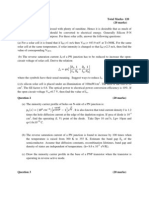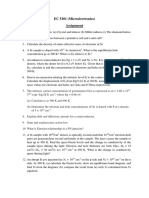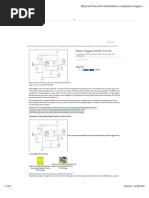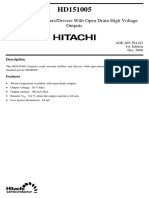0 ratings0% found this document useful (0 votes)
24 viewsTutorial 5 With Solutions
Uploaded by
f20231169Copyright
© © All Rights Reserved
Available Formats
Download as PDF, TXT or read online on Scribd
0 ratings0% found this document useful (0 votes)
24 viewsTutorial 5 With Solutions
Uploaded by
f20231169Copyright
© © All Rights Reserved
Available Formats
Download as PDF, TXT or read online on Scribd
You are on page 1/ 6
Electronic Devices
Tutorial -5
Excess Carriers
BITS Pilani, K K Birla Goa Campus
Problem 1
Consider a pure Si sample on which light of intensity 1000 W/cm2 shines (photon energy is 1.6 eV). The electron-hole
recombination time is 100 ns.
(i) Calculate the excess electron and hole densities produced by light;
(ii) Calculate the conductivity of the sample in dark and in light. The electron and hole mobilities are
µn = 1100 cm2/V.s; µp = 300 cm2/V.s
(iii) Calculate the quasi-Fermi levels for electrons and holes in the presence
of light.
absorption co coefficients = 103 cm-1
BITS Pilani, K K Birla Goa Campus
Problem 2
A bar of silicon at T = 300 K has a length of L = 0.05 cm and a cross-sectional area of A 10-5 cm2. The semiconductor is
uniformly doped with Nd = 8 x 1015 cm-3 and 𝑁𝑎 = 2 × 1015 𝑐𝑚−3 . A voltage of 10 V is applied across the length of the
material. For t < 0, the semiconductor has been uniformly illuminated with light, producing an excess carrier generation rate of
𝑔′ = 8 × 1020 𝑐𝑚−3 𝑠 −1 . The minority carrier lifetime is 𝜏𝑝0 = 5 × 10−7 𝑠. At t = 0, the light source is turned off. Determine
the current in the semiconductor as a function of time for 𝑡 ≥ 0.
BITS Pilani, K K Birla Goa Campus
Problem 3
Consider a bar of p-type silicon that is uniformly doped to a value of 𝑁𝑎 = 2 × 1016 𝑐𝑚−3 at T = 300 K. The applied electric fi
eld is zero. A light source is incident on the end of the semiconductor as shown in Figure below. The steady-state
concentration of excess carriers generated at 𝑥 = 0 𝛿𝑝 0 = 𝛿𝑛 0 = 2 × 1014 𝑐𝑚−3 . Assume the following parameters:
𝜇𝑛 = 1200 𝑐𝑚2 /𝑉𝑠, 𝜇𝑝 = 400 𝑐𝑚2 /𝑉𝑠, 𝜏𝑛0 = 10−6 𝑠, and 𝜏𝑝0 = 5 × 10−7 𝑠. Neglecting surface effects, (a) determine the
steady-state excess electron and hole concentrations as a function of distance into the semiconductor, and (b) calculate the
steady-state electron and hole diffusion current densities as a function of distance into the semiconductor.
BITS Pilani, K K Birla Goa Campus
Problem 5
Consider p-type silicon at T = 300 K doped to 𝑁𝑎 = 5 × 1014 𝑐𝑚−3 . Assume excess carriers are present and assume that
𝐸𝐹 − 𝐸𝐹𝑝 = (0.01 𝑘𝑇). (a) Does this condition correspond to low injection? Why or why not? (b) Determine 𝐸𝐹𝑛 − 𝐸𝐹𝑖
BITS Pilani, K K Birla Goa Campus
Problem 6
(a) Design a GaAs photoconductor that is 4 𝜇m thick. Assume that the material is doped at 𝑁𝑑 = 1016 𝑐𝑚−3 and has lifetime
values of 𝜏𝑛0 = 10−7 𝑠 and 𝜏𝑝0 = 5 × 10−8 𝑠. With an excitation of 𝑔′ = 1021 𝑐𝑚−3 𝑠 −1 , a photocurrent of at least 2 𝜇𝐴 is
required with an applied voltage of 2 V. (b) Repeat the design for a silicon photoconductor that has the same parameters as
given in part (a).
BITS Pilani, K K Birla Goa Campus
You might also like
- Hourglass Workout Program by Luisagiuliet 276% (21)Hourglass Workout Program by Luisagiuliet 251 pages
- The Hold Me Tight Workbook - Dr. Sue Johnson100% (16)The Hold Me Tight Workbook - Dr. Sue Johnson187 pages
- Read People Like A Book by Patrick King-Edited62% (66)Read People Like A Book by Patrick King-Edited12 pages
- Livingood, Blake - Livingood Daily Your 21-Day Guide To Experience Real Health77% (13)Livingood, Blake - Livingood Daily Your 21-Day Guide To Experience Real Health260 pages
- COSMIC CONSCIOUSNESS OF HUMANITY - PROBLEMS OF NEW COSMOGONY (V.P.Kaznacheev,. Л. V. Trofimov.)94% (212)COSMIC CONSCIOUSNESS OF HUMANITY - PROBLEMS OF NEW COSMOGONY (V.P.Kaznacheev,. Л. V. Trofimov.)212 pages
- Donald Trump & Jeffrey Epstein Rape Lawsuit and Affidavits83% (1016)Donald Trump & Jeffrey Epstein Rape Lawsuit and Affidavits13 pages
- The 36 Questions That Lead To Love - The New York Times94% (34)The 36 Questions That Lead To Love - The New York Times3 pages
- The 36 Questions That Lead To Love - The New York Times95% (21)The 36 Questions That Lead To Love - The New York Times3 pages
- Jeffrey Epstein39s Little Black Book Unredacted PDF75% (12)Jeffrey Epstein39s Little Black Book Unredacted PDF95 pages
- The 4 Hour Workweek, Expanded and Updated by Timothy Ferriss - Excerpt23% (954)The 4 Hour Workweek, Expanded and Updated by Timothy Ferriss - Excerpt38 pages
- Problem Sheet - 1: Figure 1. Conduction Band Figure 2. Valance Band0% (1)Problem Sheet - 1: Figure 1. Conduction Band Figure 2. Valance Band2 pages
- Assignments 1 FundamentalsofSemiconductor - 2023fallNo ratings yetAssignments 1 FundamentalsofSemiconductor - 2023fall3 pages
- Assignment - Electronics Devices and Circuit - Module 2No ratings yetAssignment - Electronics Devices and Circuit - Module 23 pages
- MM406: Semiconductor Devices and Processing Tutorial 1No ratings yetMM406: Semiconductor Devices and Processing Tutorial 14 pages
- BRAC University: ECE230 & EEE209 (Semiconductor Materials and Devices) Summer 2020No ratings yetBRAC University: ECE230 & EEE209 (Semiconductor Materials and Devices) Summer 20202 pages
- Physics of VLSI Devices (ECE-5018) Digital Assignment - INo ratings yetPhysics of VLSI Devices (ECE-5018) Digital Assignment - I5 pages
- EC 5101 (Microelectronics) Assignment: 17 3 0 F I 15 - 3 F INo ratings yetEC 5101 (Microelectronics) Assignment: 17 3 0 F I 15 - 3 F I2 pages
- ASSIGNMENT No. 1: BECE101L Basic Electronics (Winter 21-22) Q1: Write A Brief Note On The FollowingNo ratings yetASSIGNMENT No. 1: BECE101L Basic Electronics (Winter 21-22) Q1: Write A Brief Note On The Following1 page
- Format For Online Teacher Activities Eym Inductance 3a 03jun2021No ratings yetFormat For Online Teacher Activities Eym Inductance 3a 03jun20214 pages
- Electron Beam-Specimen Interactions and Simulation Methods in MicroscopyFrom EverandElectron Beam-Specimen Interactions and Simulation Methods in MicroscopyNo ratings yet
- "Dynamutt" Driver Board: For The Dynaco St-70No ratings yet"Dynamutt" Driver Board: For The Dynaco St-7015 pages
- Heisenberg’s Uncertainty Principle and the Electron -- Kamakhya Prasad Ghatak, Madhuchhanda Mitra, Arindam Biswas -- 2022 -- Springer -- 9789811698439 -- 43961d9ff4764ee48d38004b31ec05ca -- Anna’s ArchiveNo ratings yetHeisenberg’s Uncertainty Principle and the Electron -- Kamakhya Prasad Ghatak, Madhuchhanda Mitra, Arindam Biswas -- 2022 -- Springer -- 9789811698439 -- 43961d9ff4764ee48d38004b31ec05ca -- Anna’s Archive253 pages
- Interfacing Relays Using The Parallel Port: ContentsNo ratings yetInterfacing Relays Using The Parallel Port: Contents11 pages
- ELEC6226 Power Electronics For DC TransmissionNo ratings yetELEC6226 Power Electronics For DC Transmission20 pages
- Embedded Systems (18EC62) - Embedded System Components (Module 3)100% (4)Embedded Systems (18EC62) - Embedded System Components (Module 3)108 pages
- PDF (Ebook) Single-Inductor Multiple-Output Converters: Topologies, Implementation, and Applications by Lee, Albert Ting Leung, Jin, Weijian, Tan, Siew-Chong, Hui, Ron Shu Yuen ISBN 9781032145358, 1032145358 download100% (8)PDF (Ebook) Single-Inductor Multiple-Output Converters: Topologies, Implementation, and Applications by Lee, Albert Ting Leung, Jin, Weijian, Tan, Siew-Chong, Hui, Ron Shu Yuen ISBN 9781032145358, 1032145358 download59 pages
- Product Data Sheet: C120N - Circuit Breaker - 2P - 63A - B CurveNo ratings yetProduct Data Sheet: C120N - Circuit Breaker - 2P - 63A - B Curve2 pages
- Team Screwdriver'S: Dhole Patil Collage of Engineering PuneNo ratings yetTeam Screwdriver'S: Dhole Patil Collage of Engineering Pune38 pages
- Electronic Science: Test Booklet No. Time: 2 Hours) (Maximum Marks: 200 Instructions For The CandidatesNo ratings yetElectronic Science: Test Booklet No. Time: 2 Hours) (Maximum Marks: 200 Instructions For The Candidates32 pages
- Product Catalog For Distribution: Power SemiconductorsNo ratings yetProduct Catalog For Distribution: Power Semiconductors72 pages
- Catalytic Dehydrogenation of Z-Butanol With Zno and CuoNo ratings yetCatalytic Dehydrogenation of Z-Butanol With Zno and Cuo4 pages
- PMBLDC-Simulink - Permanent Magnet Brushless DC Motor Simulink Model.No ratings yetPMBLDC-Simulink - Permanent Magnet Brushless DC Motor Simulink Model.5 pages
- Octal Inverter Buffers/Drivers With Open Drain High Voltage OutputsNo ratings yetOctal Inverter Buffers/Drivers With Open Drain High Voltage Outputs8 pages
- Livingood, Blake - Livingood Daily Your 21-Day Guide To Experience Real HealthLivingood, Blake - Livingood Daily Your 21-Day Guide To Experience Real Health
- COSMIC CONSCIOUSNESS OF HUMANITY - PROBLEMS OF NEW COSMOGONY (V.P.Kaznacheev,. Л. V. Trofimov.)COSMIC CONSCIOUSNESS OF HUMANITY - PROBLEMS OF NEW COSMOGONY (V.P.Kaznacheev,. Л. V. Trofimov.)
- Donald Trump & Jeffrey Epstein Rape Lawsuit and AffidavitsDonald Trump & Jeffrey Epstein Rape Lawsuit and Affidavits
- The 36 Questions That Lead To Love - The New York TimesThe 36 Questions That Lead To Love - The New York Times
- The 36 Questions That Lead To Love - The New York TimesThe 36 Questions That Lead To Love - The New York Times
- Jeffrey Epstein39s Little Black Book Unredacted PDFJeffrey Epstein39s Little Black Book Unredacted PDF
- The 4 Hour Workweek, Expanded and Updated by Timothy Ferriss - ExcerptThe 4 Hour Workweek, Expanded and Updated by Timothy Ferriss - Excerpt
- Problem Sheet - 1: Figure 1. Conduction Band Figure 2. Valance BandProblem Sheet - 1: Figure 1. Conduction Band Figure 2. Valance Band
- Assignments 1 FundamentalsofSemiconductor - 2023fallAssignments 1 FundamentalsofSemiconductor - 2023fall
- Assignment - Electronics Devices and Circuit - Module 2Assignment - Electronics Devices and Circuit - Module 2
- MM406: Semiconductor Devices and Processing Tutorial 1MM406: Semiconductor Devices and Processing Tutorial 1
- BRAC University: ECE230 & EEE209 (Semiconductor Materials and Devices) Summer 2020BRAC University: ECE230 & EEE209 (Semiconductor Materials and Devices) Summer 2020
- Physics of VLSI Devices (ECE-5018) Digital Assignment - IPhysics of VLSI Devices (ECE-5018) Digital Assignment - I
- EC 5101 (Microelectronics) Assignment: 17 3 0 F I 15 - 3 F IEC 5101 (Microelectronics) Assignment: 17 3 0 F I 15 - 3 F I
- ASSIGNMENT No. 1: BECE101L Basic Electronics (Winter 21-22) Q1: Write A Brief Note On The FollowingASSIGNMENT No. 1: BECE101L Basic Electronics (Winter 21-22) Q1: Write A Brief Note On The Following
- Format For Online Teacher Activities Eym Inductance 3a 03jun2021Format For Online Teacher Activities Eym Inductance 3a 03jun2021
- Electron Beam-Specimen Interactions and Simulation Methods in MicroscopyFrom EverandElectron Beam-Specimen Interactions and Simulation Methods in Microscopy
- Heisenberg’s Uncertainty Principle and the Electron -- Kamakhya Prasad Ghatak, Madhuchhanda Mitra, Arindam Biswas -- 2022 -- Springer -- 9789811698439 -- 43961d9ff4764ee48d38004b31ec05ca -- Anna’s ArchiveHeisenberg’s Uncertainty Principle and the Electron -- Kamakhya Prasad Ghatak, Madhuchhanda Mitra, Arindam Biswas -- 2022 -- Springer -- 9789811698439 -- 43961d9ff4764ee48d38004b31ec05ca -- Anna’s Archive
- Interfacing Relays Using The Parallel Port: ContentsInterfacing Relays Using The Parallel Port: Contents
- Embedded Systems (18EC62) - Embedded System Components (Module 3)Embedded Systems (18EC62) - Embedded System Components (Module 3)
- PDF (Ebook) Single-Inductor Multiple-Output Converters: Topologies, Implementation, and Applications by Lee, Albert Ting Leung, Jin, Weijian, Tan, Siew-Chong, Hui, Ron Shu Yuen ISBN 9781032145358, 1032145358 downloadPDF (Ebook) Single-Inductor Multiple-Output Converters: Topologies, Implementation, and Applications by Lee, Albert Ting Leung, Jin, Weijian, Tan, Siew-Chong, Hui, Ron Shu Yuen ISBN 9781032145358, 1032145358 download
- Product Data Sheet: C120N - Circuit Breaker - 2P - 63A - B CurveProduct Data Sheet: C120N - Circuit Breaker - 2P - 63A - B Curve
- Team Screwdriver'S: Dhole Patil Collage of Engineering PuneTeam Screwdriver'S: Dhole Patil Collage of Engineering Pune
- Electronic Science: Test Booklet No. Time: 2 Hours) (Maximum Marks: 200 Instructions For The CandidatesElectronic Science: Test Booklet No. Time: 2 Hours) (Maximum Marks: 200 Instructions For The Candidates
- Product Catalog For Distribution: Power SemiconductorsProduct Catalog For Distribution: Power Semiconductors
- Catalytic Dehydrogenation of Z-Butanol With Zno and CuoCatalytic Dehydrogenation of Z-Butanol With Zno and Cuo
- PMBLDC-Simulink - Permanent Magnet Brushless DC Motor Simulink Model.PMBLDC-Simulink - Permanent Magnet Brushless DC Motor Simulink Model.
- Octal Inverter Buffers/Drivers With Open Drain High Voltage OutputsOctal Inverter Buffers/Drivers With Open Drain High Voltage Outputs























































































































